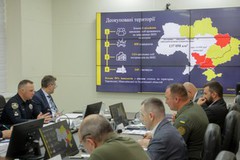Potentially mined land area has decreased by more than 20% compared to the end of 2022: Denys Shmyhal

The state of implementation of humanitarian demining measures was discussed at a meeting at the Mine Action Office of the State Emergency Service of Ukraine (SESU). According to the Prime Minister of Ukraine Denys Shmyhal, Ukraine has made significant progress in clearing Ukrainian land of explosive ordnance. At the same time, the Head of Government accentuated the challenges that need to be addressed.
According to him, the area of potentially mined land has decreased by more than 20% compared to the end of 2022 and today amounts to about 137,000 km2. These are mostly agricultural lands. The SESU, the National Police, the Ministry of Defence and non-governmental mine action operators are carrying out the clearance work. The resource of 112 certified operators, including eight foreign operators currently working in Ukraine, includes more than 9,000 specialists, 278 units of demining and excavating equipment, and more than 13,000 metal detectors.
During the meeting, the First Deputy Prime Minister - Minister of Economy, Minister of Agrarian Policy and Minister of Internal Affairs delivered reports. The participants discussed proposals to strengthen demining support for farmers.
"The State Agrarian Register should become the only tool for interaction in providing compensation for the costs of humanitarian demining of agricultural land. Data should be entered into the register more promptly," the Prime Minister emphasized.
The participants also heard information from the Ministry of Defence on demining of the frontline territories.
“We agreed with the ministries to redistribute powers in the field of operational and humanitarian demining to improve coordination of the process,” said Denys Shmyhal.
Following the meeting, the Head of Government assigned a number of tasks to the ministries and responsible officials. Among them, in particular, to accelerate the launch of the Register of territories contaminated with explosive objects, as well as to develop an action plan to attract international funding directly for demining activities. The Prime Minister noted that Ukraine has already formed a large international demining capability coalition of more than fifty states and attracted USD 1.2 billion in assistance for the cleanup of territories.
"Humanitarian demining is a key element of rapid recovery. Our goal is to constantly increase the pace of work to clear Ukrainian fields, villages, cities, and infrastructure of mines as soon as possible," emphasized Denys Shmyhal.
UNDP hands over innovative remote mine detection system to SES
The United Nations Development Programme in Ukraine has handed over the Mines Eye aerial reconnaissance system to the State Emergency Service of Ukraine. This state-of-the-art unmanned technology uses sensors to remotely detect mines and other explosive hazards, making mine clearance faster, more accurate and safer. Mines Eye is a development of the Ukrainian team that participated in the first Demining Bootcamp and regularly participated in the testing of sensor technologies organised by UNDP in cooperation with the Ministry of Economy.
"Innovation is the future of humanitarian demining. In just a year and a half, projects that were at the level of ideas are already successfully surveying hundreds of hectares of fields. And they do it so well that the SES, whose specialists have been working with the system for several months in trial operation, is buying it with the support of UNDP and funding from Luxembourg. It's a win-win situation, as the rescuers have received modern equipment for field surveys, and innovators understand that their developments are in demand," said Deputy Minister of Economy of Ukraine Ihor Bezkaravaynyi.
The Mines Eye system uses a magnetometer with high-precision aerial and infrared imaging to remotely inspect large contaminated areas. Using artificial intelligence, the technology identifies explosive remnants of war, including anti-tank mines, even under vegetation. Mines Eye provides operators with detailed maps and reports on anomalies, which allows for high-quality planning of manual or mechanical demining before starting work on the ground.
"Ukraine's technological ingenuity, strengthened by international support, is helping to change the very approach to humanitarian demining. Our priority is clear: to ensure access to land, restore livelihoods and support Ukraine's recovery through technological, coordinated and evidence-based solutions. With these tools, we can return land to communities faster and more safely, ensuring protection for those in need. Humanitarian demining is not just about clearing mines, it is also about restoring security, restoring lives and developing economic potential," said UN Assistant Secretary-General and UNDP Acting Administrator Haoliang Xu, who took part in the system handover.
Over the course of five months, the SES deminers who participated in the UNDP training surveyed more than 360 hectares of confirmed and potentially dangerous areas in Kharkiv and Mykolaiv regions, some of the most heavily mined regions of Ukraine.
"Mines Eye is a smart solution that allows us to survey hazardous areas quickly, accurately and without risk to people. The system can detect threats in areas where it is too dangerous to work manually. We are grateful to our international partners for their support - not only here and now, but also in building long-term solutions that return safety step by step, metre by metre," said First Deputy Head of the State Emergency Service of Ukraine Vitalii Myroniuk.
The Mines Eye system will be integrated into the operational work of the SES and will be used throughout Ukraine to support humanitarian demining in conditions of difficult terrain, limited access or high contamination density.
Background information
UNDP, in cooperation with the Ministry of Economy of Ukraine and international partners, is implementing a comprehensive, technology-led approach to humanitarian demining. This includes testing unmanned and underwater systems, enhancing technical survey capacity and strengthening national coordination.
- 1754 reads








